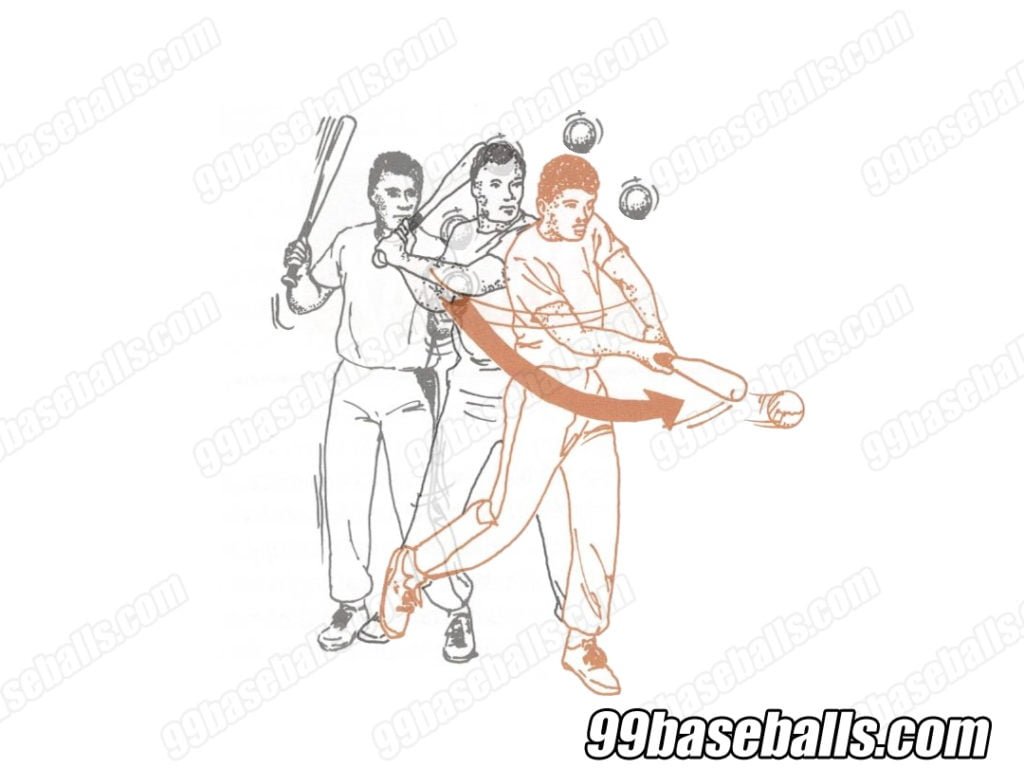- The term “fungo” is used to describe a coach hitting ground balls or fly balls to his players during practice
- Fungo bat is a special, lighter bat made for fungoing baseballs
- Fungo hitting can also be done by players to develop their hand-eye coordination

Intro
It was a sunny afternoon at a small-town baseball field, and I stood near the home plate, struggling to keep the kids focused on grounders and popflies with my poor fungo skills.
As a new coach for bunch of rambunctious, eight-year old kids, I was doing a poor job keeping them engaged in the drills. The practice was taking too long, and kids were definitely not having fun.
Suddenly, a 60-something year old coach emerged from the shadows, clutching a well-worn, taped bat.
“Hey coach, do you need a hand?”, the older gentleman asked me. I was exhausted and frustrated after hitting five buckets of crappy fungo balls so I said sure.
He replied, “I see that you are working with a heavy bat. This is a fungo bat,” he said with a smile. “It possesses the power to shape dreams and transform ordinary players and coaches into extraordinary ones.”
I initially laughed, but watched in awe as this older coach gracefully lifted the bat and effortlessly propelled balls into the outfield and sharp grounders to infielders with uncanny accuracy. Now, kids were more focused and having fun with eac other.
Since then, I have learned the art of fungo hitting and used many fungo bats. I like to share my experience with you so that you can learn how to use this valuable tool.
Table of Contents
- What is Fungo?
- What is a Fungo Bat?
- Benefits and Drawbacks of Using a Fungo Bat
- How to Protect Your Fungo Bat
- The Future of Fungo – Fungo Bat or Pitching Machine?
- How to Grip a Fungo Bat
- Fungo Bat Swing – Tossing a Ball
- Hitting Technique – Fungo Ground balls
- Hitting Technique – Fungo Fly balls
- Fungo Drills
- Practice, Practice, and Practice
- Takeaways
- Frequently Asked Questions
- Video Tutorials
What is Fungo?
The exact origins of the word “fungo” remain elusive, it gained prominence in the late 19th century, a time when baseball was rapidly evolving.
Some say it was a contracted version of “fun go”, others say the original word was “fungoes”, as in “fun goes” but there is no written records to verify these claims.
However, the Scottish uses the word “fung” to describe a “pitch, toss, or fling” (citation: fungo | Etymology, origin and meaning of fungo by etymonline) so perhaps there is some truth to this claim?
In general, if a coach says “fun-go” (or “fung-go”), they are describing hitting action. On the other hand, if a coach says “fungo bat”, they are describing a special baseball bat made for fungo.
Below are some sample ways of describing fungo:
- “Let’s do some pre-game fungo”
- “Do we want to start the drill with some fungoes?”
- “Some coaches don’t even know hot to hit fungoes”
- “We need to fungo some grounders”
- “Let’s fungo popflies to left field”
- “Look, those coaches are hitting fungos”
- “Fungoing popups for catchers kills my lower back”
- “Don’t let Johnny use my fungo bat!”
Regardless of using a fungo bat or regular bat, “fungoing” activity is crucial in player development.
What is a Fungo Bat?
Fungo bats are longer, narrower, and lighter, enabling coaches to generate precise hits with ease with less fatigue than regular bats. It also allows you to hit pop flies that are 250-300 feet deep with minimal amount of effort.

Fungo bats and traditional bats can be made from wood, metal, or composite materials, although wood is the most common material used for fungo bats.
For more information on wood types used in making fungo baseballs, read What Should I look for in a baseball bat post.
Length
The length of a fungo bat is significantly longer than conventional bats to enhance a coach’s reach, allowing them to accurately hit the ball to various fielding positions.
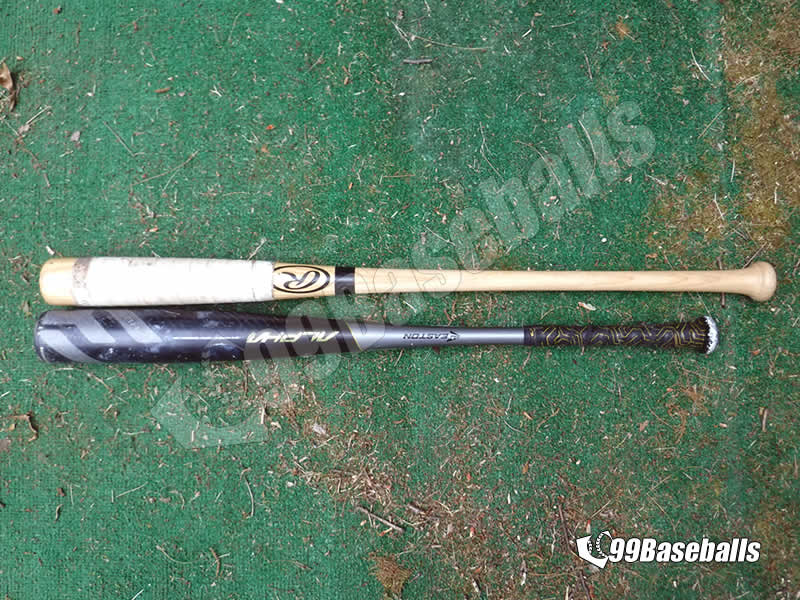
Also, many professional baseball coaches use fungo bats with various lengths, depending on the situation:
- To fungo baseballs to infielders (ad popup flyballs to catchers), coaches use fungo bats that are 34 to 35 inches in length
- To fungo baseballs to outfielders, coaches use fungo bats that are 36 to 37 inches in length
Most non-professional coaches (i.e. college, high school, etc.) will use fungo bats that are 35 to 36 inches long for both types of drills.
You should keep in mind that your height will ultimately dictate the length (taller coaches use longer fungo bats).
Barrel size
In order to make fungo bats lighter, the diameter of a barrel is reduced. Many fungo bats have a dimeter of approximately 2” fungo bats come with 2 ¼” (7 3/8” or 7.375inches in circumference)dimeter barrel size.
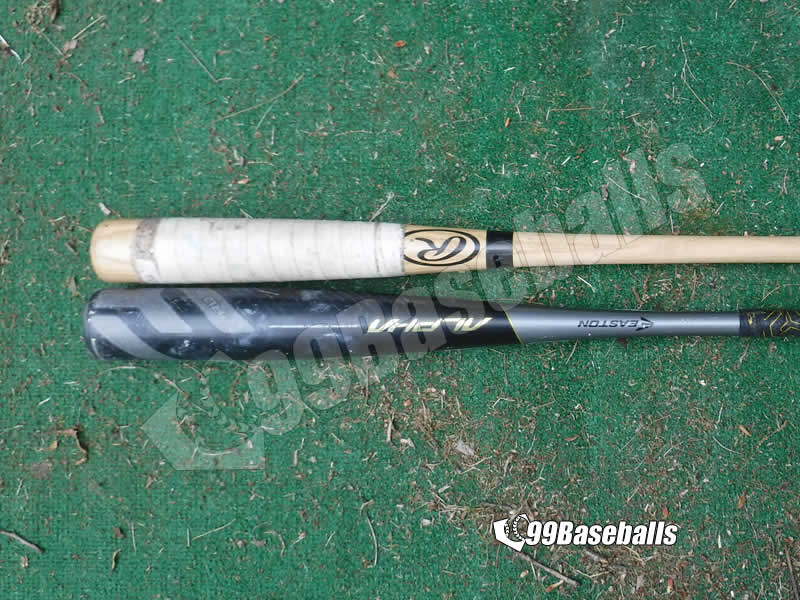
In comparison, regular youth bats come in 2 ½”, 2 5/8”, or 2 ¾” barrel sizes. Most professional wood bats come with a 2 5/8” barrel (42” maximum length).
Smaller Sweet spot
Sweet spot is an area of a bat that exerts the least number of waves (cause of bat stings) when it hits a baseball.
Due to weight reduction goals, the sweet spot on a fungo bat is considerably smaller than a regular bat. This is usually not a problem since coaches have better hand-eye coordination from years of experience.
Cupped end cap
End cap is the furthest point away from the handle part of a bat and many fungo bats come with a cupped or hollowed out end cap (usually extended about 6 inches) to reduce weight.
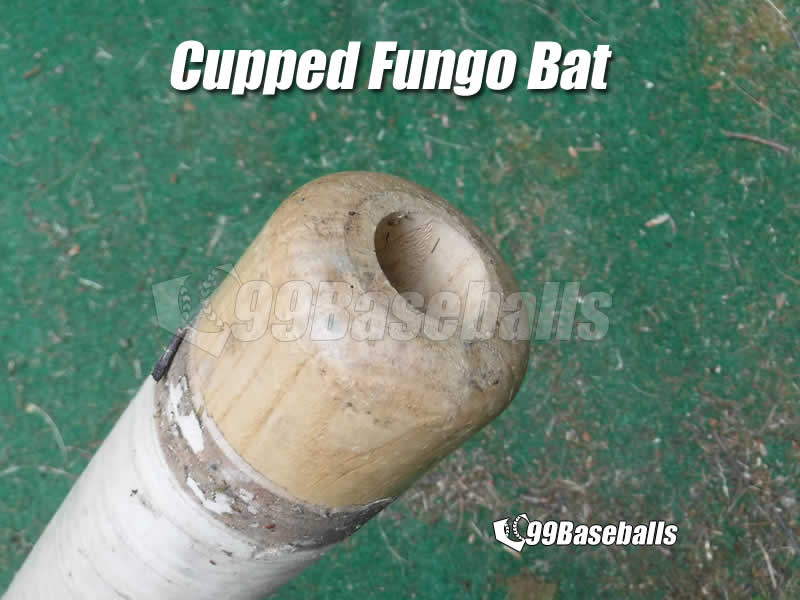
Benefits and Drawbacks of Using a Fungo Bat
In order to have a skilled baseball team, you need to practice often. Due to school work and field availability, practice timeslots, when all players can attend, is hard to come by. Thus it is absolutely imperative conduct a pre-planned practice that is both efficient and interesting and using a fungo bat can help you accomplish those goals.
Usually when a coach fungoes a ball, the ball is usually hit dead on, resulting in a batted ball with little to no spin.
In contrast, hitting a thrown ball imparts a lot of spin, primarily due to the rotation created by the pitcher and the batter hitting just below or above the center of a ball.
Fielding a fungoed ground ball is similar to fielding a batted, knuckle ball. The lack of spin introduces little movement and it is actually quite slower when compared to a batted ball with a backspin with 7,000-8000 RPM. The no-spin batted ball also tends to travel straight which is not the case for batted balls with a spin.
The same holds true when shagging fungoed flyballs. If the ball is hit dead on, the fly ball will travel in a straight line. If you have played left or right field, you know that the batted balls usually shanks or hooks, and rarely travel straight.
For beginner youth players, basic fungo with no back spin is not really an issue as they need to focus on tracking balls first.
However, for advanced youth players, a coach really needs to practice their fungo skills to introduce back spins. If a coach is unable to do that, he or she may want to explore using a three-wheeled pitching machine to conduct fielding drills.
Benefits of Using a Fungo Bat
- Precision Hitting – Fungo bats allow coaches to precisely control the trajectory, distance, and speed of the hit balls. This precision facilitates tailored practice sessions, focusing on specific fielding scenarios and honing players’ skills accordingly
- Efficiency – The lightweight nature of fungo bats enables coaches to engage in extended practice sessions without experiencing undue strain or fatigue. Coaches can seamlessly transition between hitting repetitions, maximizing the efficiency of practice time
- Enhanced Fielding Repetition: Fungo’s unique design allows coaches to hit high-arcing balls, providing players with more time to read and react to each play. This extended flight path enhances the repetition of fielding techniques and reinforces muscle memory.
- Simplicity – all you need is a bucket of balls and a bat; no need to electricity for a pitching machine
Drawbacks of Using a Fungo Bat
- Little to no baseball spin – When a batter hits a pitch, a forward or backspin is forced on the ball. When fungoing grounders or pooflies, there is little to no spin on the ball because dropped balls are hit squarely. More experienced coaches can induce a spin by hitting either the top or lower portion of the ball
- Limited Power Hitting – Due to their lightweight construction, fungo bats are not designed for generating significant power or driving line drive a ball deep into the outfield. Therefore, they are not suitable for teaching power-hitting techniques
- Skill Requirement – Mastery of the fungo bat requires practice and precision. Coaches must develop a proper swing technique to consistently hit the ball where intended. This learning curve may pose a challenge for inexperienced coaches.
- Limited durability – In my experience, a wood fungo bat lasts about five months, no matter how careful you are with it. Metal fungo bats fare better, but hard hit balls will likely cause undesirable dents or flat spots.
How to Protect Your Fungo Bat
Due to its design, wood fungo bats will break easily if it is not used with care.
So there are few things you should do to limit the risk of damage:
- Apply a fungo bat tape
- Focus on hitting the sweet spot
- Hit only with a soft-tossed balls
How to Tape a Fungo Bat
Get a roll of white, waterproof, athletic tape and tightly wrap the barrel in two layers. I like to wrap the first layer by butt-joining the tape, then reverse the direction for the second layer with an overlapping design.
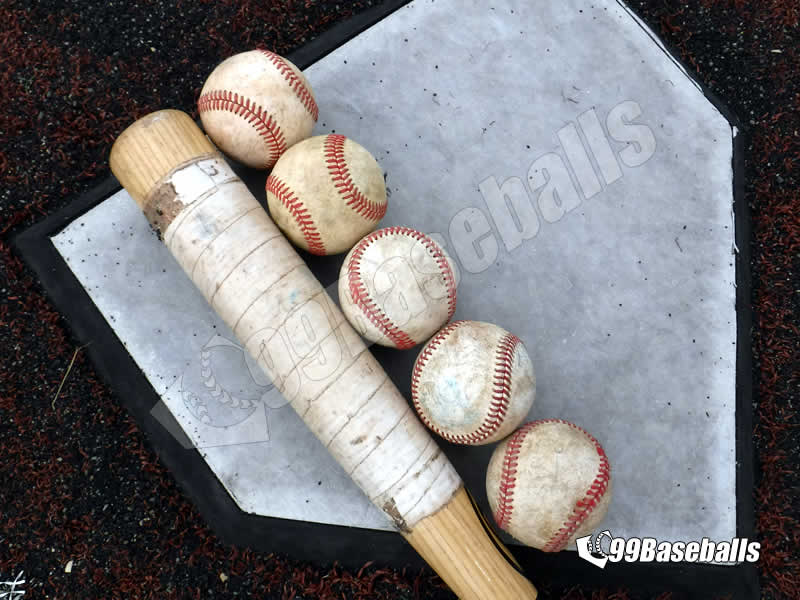
I don’t use black electrical tapes because they will soften and glue will separate during hot practice, attracting dirt (that cannot be easily wiped off) and leave streak marks on my baseballs.
Hitting the Sweet Spot
Many fungo bats come with a cupped end. If you constantly hit baseballs at the end of the fungo, you will break it sooner than later. Practice hitting sweet spot using a regular bat before using a wood fungo bat.
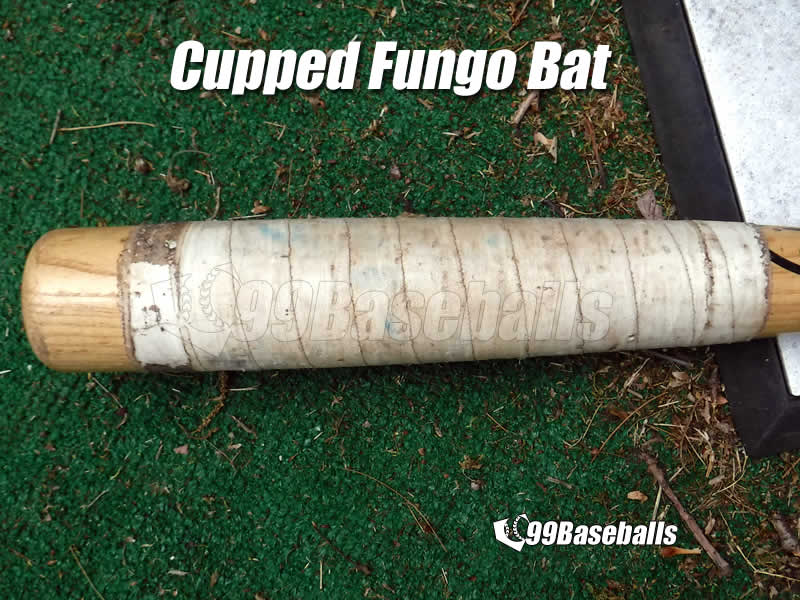
The tapered handled area is very fragile as well so avoid hitting near the handle.
Hit only with a soft-tossed balls
I have seen countless kids using fungo bats for batting practice. Hitting off of a pitch is a sure fire way to break the fungo bat because the handle on a fungo bat is extremely fragile.

The Future of Fungo – Fungo Bat or Pitching Machine?
When it comes to fielding a ground ball or popup flies, combining and processing the visual and auditory cues are very important to a fielder.
For infielders, seeing where the bat contacts the ball provides important information to get a good jump start to block the ball from getting to the outfield.
For outfielders, watching the bat swing, hearing the sound of a crack, and subsequent ball path provide crucial, split-second information to calculate the ball trajectory and approximate the landing spot (the idea is to run to the landing spot first).

These are the solid reasons why fungo bats have been used for over 75 years to train baseball players.
Today, there are two options when it comes to hitting fungoes:
- Fungo bat, regular bat, fungo racket, tennis racket, or Accubat
- Pitching machines (one wheel machine, which is the least expensive type, is fine for fungo)
Death of Fungo and Fungo Bat?
The latest trend has been to replace traditional fungo bats with pitching machines, even at professional level. It is common for many MLB teams to ditch their fungo bats in favor of pitching machines. In these situations, you will see two or three coaches whose job is to feed baseballs into Hack Attack of Atec R2 three-wheeled pitching machines to simulate ground balls and pop flies.
Unlike the fungo batted balls, which tend to have limited ball spins, pitching machines can be setup to induce either the forward or backward spins for infielders and outfielders.
And I agree that knowing how to use the fungo bats should be a requirement for coaches at the college and professional levels as outlined in the “Death of the Fungo” post by BallNine.com (https://ballnine.com/2022/09/07/death-of-the-fungo/).
BUT, when it comes to coaching youth baseball players, their need to reinforce basic skills are far greater than college or professional ball players.
Personally, I like to use fungo bats and pitching machines to conduct drills.
I have coached a team with 16 players (9U level) and I can tell you that it is really hard to keep all of them engaged. By using a fungo bat for infield grounders and a pitching machine for outfield pop flies, your practice can both be fun and efficient.
The bottom line is that if you can afford a used pitching machine (even a single wheeled Atec Rookie machine), and there is an outlet available, it can be a valuable tool in developing your players, but you should still hone your fungo bat skills for away games.
How to Grip a Fungo Bat
Just like holding a regular bat, if you are batting “righty” (standing on the left batter’s box), your right hand is positioned above your weak hand when gripping a bat.
If you are batting “lefty” (standing on the right batter’s box), your left hand is positioned above your weak hand when gripping a bat.
This gripping position does not change, regardless of which hand you use to toss a baseball.
Fungo Bat Swing – Tossing a Ball
There are two ways of gripping the bat when hitting fungo. There is no correct way of doing it, other than the fact that the decision is purely driven by personal preference.
Try both methods as you may discover that you might be better at tossing with your weak hand.
Method # 1 – Toss the ball with your dominant hand
If you are a right-handed person, you will grip the bat with your left (weak) hand, then toss the ball with your right hand.
Once the ball is tossed, you can grab the bat with your right hand before swinging.
If you are a left-handed person, you will grip the bat with your right (weak) hand, then toss the ball with your left hand.
Once the ball is tossed, you can grab the bat with your left hand before swinging.
Method # 2 – Toss the ball with your weak hand
If you are a right-handed person, you will grip the bat with your right (dominant) hand, then toss the ball with your left (weak) hand.
Once the ball is tossed, you can grab the bat with your left hand before swinging.
If you are a left-handed person, you will grip the bat with your left (dominant) hand, then toss the ball with your right (weak) hand.
Once the ball is tossed, you can grab the bat with your right (weak) hand before swinging.
| Tip |
|---|
| A common issue with Method # 2 is that inexperienced hitters tend to grab the bat over the knob of a baseball bat. This results in poor bat control so make sure to learn where your dominant hand should be positioned over the bat. |
Hitting Technique – Fungo Ground balls
Fungoing ground balls is a great way for you infielders to practice their defensive skills.
Begin by holding a ball in your hand and grip the bat using one of the methods mentioned in the previous section.
Hold the bat high by your rear shoulder, and toss the ball out in front your front foot.
Quickly place your tossing hand to the bat and allow the ball to drop to your belly button region.
| Hitting Tip |
|---|
| I highly recommend gripping the bat with two hands for maximum control. You will also tire less easily, especially if you are hitting multiple buckets of balls. |
You want to hit grounders, so make sure to let the ball drop just below waist height before making contact.
Shift your weight from back to front, and step towards the player as you begin your swing.
Swing through the ball and be sure to start the bat high so that your swing path is high to low to force the ball go down onto the ground.
Make sure to watch the ball make contact before shifting your focus to the player.
Depending on the age and their skills, you will have to adjust how hard you hit the ball.
You will also want to make sure that your tossing shoulder is pointed toward the intended target.
step toward the fielderin you front foot as you beging your swing. watch teh ball until you make contact
Hitting Technique – Fungo Fly balls
Fungoing flyballs is similar to hitting groung balls, except that the swing path is from low to high and the contact is made above the waist.
You need to toss the ball higher and the bat must begin the swing below your rear shoulder.
First, shift your weight onto your back foot and drop your rear shoulder, then toss the ball about 12 inches above your head.
Grip the bat with both hands and swing up at the ball.
You want to make contact with the ball at about shoulder height.
Take a step forward into your swing as you did when hitting ground balls.
Make sure to follow through swing arc with your hands and the bat finishing well above your shoulders.

Fungo Drills
There are many variations of drills and warmup routines.
Just a note that when it comes to “fungo hitting”, some coaches like to wear a fielding glove to toss a ball, then swing the bat with one hand [image]. This way, all his players practice fielding a ball.
I never used this approach. From years of tossing hundreds of thousands of BP pitches, I developed an elbow pain on my throwing arm. Swinging the fungo bat with one arm always exacerbated my elbow pain so always used two hands to swing.
Pre-game fungo warmups
Coach and a catcher on a foul line (either left or right field), about half the distance between the first base and outfield wall.
One or two “relay” infielders stands about 50 feet away from the coach
Kids form a line about 150 feet away from the infielder
The coach “fungoes” popflys to the outfielder, who throws the ball to the relay infielder, who in turn throws it to the catcher. Infielders are rotated so everyone gets three or four attempts
Infield fungo drills
You can focus on stationary fielding skills (hit fungo to each infield position), or combine fielding and throwing for situational play. As a coach, you will need to hit the top portion of the ball for top spin to mimic a batted ball from a pitcher. Hit the bottom portion of the ball to simulate infield popup fly balls.
Outfield fungo drills
Traditionally, you hit fungos from a spot that is about 10 feet away from the batter’s boxes (closer to outfield). You don’t stand in the batter’s box because you don’t want to wear out the spot.
Again, you can focus on catching, or combine with throwing to a cutoff or relay for simulated game play.
Practice, Practice, and Practice
If it has been awhile since you last picked up a baseball bat, it will take some practice to become an efficient fungo hitter.
When fungoing a ground ball, the most common error is tossing the ball too high, resulting in poor timing. A proper tossing height is around your eyes, not above your head. The swing path of a bat should be parallel to the ground.
When fungoing a fly ball, the most common error is swinging the bat without an “arc”. Unlike fungoing ground balls, a proper tossing height is above your head, and you want to simulate an upper cut to a ball.
In both cases, you want to make sure that the ball is not tossed too close to your body, which forced you to jam the bat.
Stand in a batter’s box and while taking a batting stance, extend your arm out. The position of your hand is where you want the ball to end up.
Bring bucket of baseballs and some empty buckets to practice on the field without your players. Position empty bucks at various infield and outfield positions and try to hit those buckets with your fungo baseballs.
Once you hit all the balls, then go to the outfield and hit them back to the home plate area, rather than simply collecting them
Takeaways
As a former youth baseball player, then later as a coach and manager, my love for baseball runs deep. The sights, sounds, and smells of the game bring back cherished memories, and I am fortunate to have the opportunity to have gained small, hard-to-find nuanced knowledge over the years.
I hope you found this post to be helpful in your quest to become a better fungo hitter.
Frequently Asked Questions
- Are fungo bats leagal?
- Fungo bats are not legal for gameplay. Typically used by coaches, fungo bats are designed to be used during practice to hit ground balls and pop flies.
- Can fungo bats be used by players during practice?
- No, fungo bats have small-diameter barrels and are not designed to be used in power-swing situations as they will easily break
- Why do coaches tape fungo bats?
- Experienced coaches will tape the barrel of a fungo bat to minimize the risk of splintering the barrel. Some coaches will also tape the handle of the bat for more comfort, though most coaches leave it bare for better tactile feedback
- How do you hit fungo like a pro?
- Like we tell our kids, fungo hitting requires practice. With proper techniques mentioned in this post [99baseballs.com how to hit fungo], you will get better at fungo with repetition
- Can I just use a regular baseball bat instead of a fungo bat?
- Yes, you can grab one of your kid’s bat and fungo popup flies and grounders. But after a bucket or two, you will start to tire out. For tee ball players, you may want to just throw the ball. For 6 to 9 year old players, you can use a tennis racket (use tennis balls, not baseballs)
- Why is fungo better than using a regular baseball bat?
- Fungo bats lighter so you don’t get tired quickly. Light weight bats also provide enhanced bat control
Video Tutorials
Here are useful videos on fungo batting

